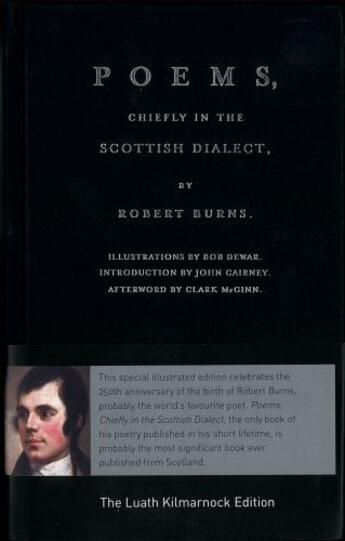-
Nombre de pages : (-)
-
Collection :
(-)
-
Genre :
(-)
-
Thème :
Non attribué
-
Prix littéraire(s) :
(-)
Résumé:
Poems, Chiefly in the Scottish Dialect, was the first collection of poetry produced by Robert Burns. Published in Kilmarnock in July 1786 it has become known as The Kilmarnock Edition. The contents include 44 of Burns' best known poems including To a Louse, The Cotter's Saturday Night, To a... Voir plus
Poems, Chiefly in the Scottish Dialect, was the first collection of poetry produced by Robert Burns. Published in Kilmarnock in July 1786 it has become known as The Kilmarnock Edition. The contents include 44 of Burns' best known poems including To a Louse, The Cotter's Saturday Night, To a Mouse, The Twa Dogs and To a Mountain Daisy. Released in 2009 to celebrate Burns' 250th birthday, The Luath Kilmarnock Edition brought this classic of Scottish literature back into print, after being unavailable for many years. New material includes an introduction by 'the man who played Burns' author, actor and Burns expert John Cairney, exploring Burns' life and work, especially the origins of The Kilmarnock Edition. Looking to the future of Burns in Scotland and the rest of the world, Clark McGinn, world-renowned Burns Supper speaker, provides an afterword that speaks to Burns' continuing legacy. Illustrated throughout with original line drawings by top political satirist Bob Dewar, The Luath Kilmarnock Edition makes a beautiful gift for any Burns enthusiast."This special illustrated edition celebrates the 250th anniversary of the birth of Robert Burns, probably the world's favourite poet. Poems Cheifly in the Scottish Dialect, the only book of his poetry published in his short lifetime, is probably the most significant book ever published from Scotland. Kilmarnock saw that first edition of a young man's poems published in 1786 and Burns has not beeen out of print for a single day since. We are still reading, reciting and enjoying these poems... the writing, life and character of this Ayrshire ploughman inspire deep human emotion around the globe. - FROM THE AFTERWORD BY CLARK McGINN
Donner votre avis









